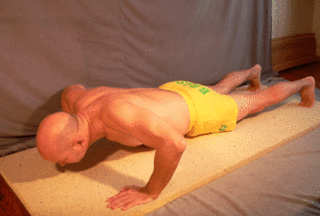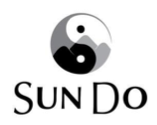
Calisthenics or callisthenics (/ˌkælɪsˈθɛnɪks/) is a form of strength training consisting of a variety of movements that exercise large muscle groups, such as standing, grasping, pushing, etc.

Physical fitness is a state of health and well-being and, more specifically, the ability to perform aspects of sports, occupations and daily activities. Physical fitness is generally achieved through proper nutrition, moderate-vigorous physical exercise, and sufficient rest along with a formal recovery plan.

Pilates is a type of mind-body exercise developed in the early 20th century by German physical trainer Joseph Pilates, after whom it was named. Pilates called his method "Contrology". It is practiced worldwide, especially in countries such as Australia, Canada, South Korea, the United States and the United Kingdom. Pilates uses a combination of around 50 repetitive exercises to spur muscle exertion. Each exercise flows from the "five essentials": breath, cervical alignment, rib and scapular stabilization, pelvic mobility, and utilization of the transverses abdomens. Each exercise is typically repeated three to five times. As of 2023, over 12 million people practice Pilates.

Charles Atlas was an Italian-American bodybuilder best remembered as the developer of a bodybuilding method and its associated exercise program which spawned a landmark advertising campaign featuring his name and likeness; it has been described as one of the longest-lasting and most memorable ad campaigns of all time.

The push-up is a common calisthenics exercise beginning from the prone position. By raising and lowering the body using the arms, push-ups exercise the pectoral muscles, triceps, and anterior deltoids, with ancillary benefits to the rest of the deltoids, serratus anterior, coracobrachialis and the midsection as a whole. Push-ups are a basic exercise used in civilian athletic training or physical education and commonly in military physical training. They are also a common form of punishment used in the military, school sport, and some martial arts disciplines. Variations of push-ups, such as wide-arm push-ups, diamond push-ups target specific muscle groups and provide further challenges.

Stretching is a form of physical exercise in which a specific muscle or tendon is deliberately expanded and flexed in order to improve the muscle's felt elasticity and achieve comfortable muscle tone. The result is a feeling of increased muscle control, flexibility, and range of motion. Stretching is also used therapeutically to alleviate cramps and to improve function in daily activities by increasing range of motion.

An isometric exercise is an exercise involving the static contraction of a muscle without any visible movement in the angle of the joint. The term "isometric" combines the Greek words isos (equal) and -metria (measuring), meaning that in these exercises the length of the muscle and the angle of the joint do not change, though contraction strength may be varied. This is in contrast to isotonic contractions, in which the contraction strength does not change, though the muscle length and joint angle do.

Plyometrics, also known as jump training or plyos, are exercises in which muscles exert maximum force in short intervals of time, with the goal of increasing power (speed-strength). This training focuses on learning to move from a muscle extension to a contraction in a rapid or "explosive" manner, such as in specialized repeated jumping. Plyometrics are primarily used by athletes, especially martial artists, sprinters and high jumpers, to improve performance, and are used in the fitness field to a much lesser degree.
Maxalding is an exercise system of muscle control using a form of isometrics. Books and pamphlets teaching the system were first published in 1909 and continued until Maxalding ceased to trade in the late 1970s.

A vocal warm-up is a series of exercises meant to prepare the voice for singing, acting, or other use.
Bullworker is a product and fitness company that specializes in isometric exercise, that is the static contraction of a muscle without any visible movement. The original portable home fitness device was invented by Gert F. Kölbel in 1962.
In an isotonic contraction, tension remains the same, whilst the muscle's length changes. Isotonic contractions differ from isokinetic contractions in that in isokinetic contractions the muscle speed remains constant. While superficially identical, as the muscle's force changes via the length-tension relationship during a contraction, an isotonic contraction will keep force constant while velocity changes, but an isokinetic contraction will keep velocity constant while force changes. A near isotonic contraction is known as Auxotonic contraction.

The Roman chair is a piece of exercise equipment. It is mainly used for the lower back, but can also target the buttocks, hamstrings, and abdomen. The definition of the equipment, and what 'Roman chair exercise' specifically means, is not clear.
In kinesiology, core stability is a person's ability to stabilize their core. Stability, in this context, should be considered as an ability to control the position and movement of the core. Thus, if a person has greater core stability, they have a greater level of control over the position and movement of this area of their body. The body's core is frequently involved in aiding other movements of the body, such as running; thus it is known that improving core stability also improves a person's ability to perform these other movements.
An isometric exercise tool is a device used to exercise most body parts including the wrist and is often used as part of physical therapy or in order to build muscle strength in a low impact manner. Devices can range in size from large bulky machines used by physicians to small hand-held devices that can be used by an individual. Isometric devices have been used for centuries. The first devices did not display the users' output; nowadays there are devices that can digitally output the users force. Before that some devices used an analog format.

Brian Sterling-Vete is an English author, Guinness World Record Holder, motivational speaker, TV broadcaster, Director, Stage, Film and Television actor, stunt performer, martial arts expert, fitness expert and entrepreneur.
Street workouts are a physical activity performed in outdoor parks or public facilities. The movement behind street workouts became popular in Russia, Israel, Myanmar, Morocco, Eastern Europe, and the United States, especially in New York City, Los Angeles, Chicago, Philadelphia, Miami, Baltimore, Washington, D.C., and other urban East Coast neighborhoods. It is a combination of athletics, calisthenics, and sports. "Street workout" is a modern name for calisthenics in outdoor parks. There are also street workout teams and organized competitions for exercises such as pull-ups, chin-ups, push-ups, dips, rows, muscle-ups, sit-ups and squats. A street workout also involves static (isometric) holds such as the human flag, front lever, back lever, L-sit and planche.

Power training typically involves exercises which apply the maximum amount of force as fast as possible; on the basis that strength + speed = power. Jumping with weights or throwing weights are two examples of power training exercises. Regular weight training exercises such as the clean and jerk and power clean may also be considered as being power training exercises due to the explosive speed required to complete the lifts. Power training may also involve contrasting exercises such as heavy lifts and plyometrics, known as complex training, in an attempt to combine the maximal lifting exertions with dynamic movements. This combination of a high strength exercise with a high speed exercise may lead to an increased ability to apply power. Power training frequently specifically utilises two physiological processes which increase in conjunction with one another during exercise. These are deep breathing, which results in increased intra-abdominal pressure; and post-activation potentation, which is the enhanced activation of the nervous system and increased muscle fibre recruitment. Power training programmes may be shaped to increase the trainee's ability to apply power in general, to meet sports specific criteria, or both.

Barre is a form of physical exercise, usually conducted in group classes in gyms or specialty studios. It is distinguished from other group fitness activities by its use of the ballet barre and its incorporation of movements derived from ballet. These classical dance movements and positions are combined with those drawn from yoga and pilates, and other equipment is sometimes used in addition to the barre, such as resistance bands, yoga straps, exercise balls and hand weights. Barre classes typically focus on small, pulsing movements with emphasis on form, alignment and core engagement. Participants hold their bodies still while contracting specific, targeted sets of muscles in isometric exercises. Repetitions tend to be high, range-of-motion small, and weights, when used, light. Barre classes focus on the lower body and core, developing strength and flexibility from the ankles up though the calves, knees, thighs, glutes and abdominals. Holding muscles in contraction for extended periods frequently leads to them shaking as they fatigue. This is particularly true of thighs, as the quadriceps tire.

Sundo - also known as Kouk Sun Do (국선도) - is a Korean Taoist art based on meditation, and which aims at the personal development of its practitioners, both at the physical, mental and spiritual levels.













